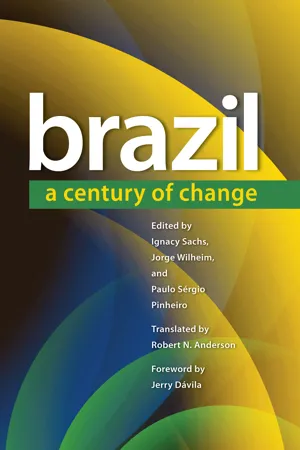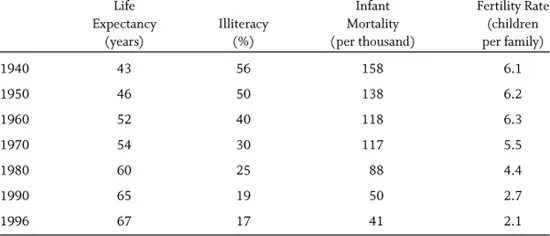![]()
1: A Cartographic and Statistical Portrait of Twentieth-Century Brazil
Hervé Thery
The word “transformation” covers a broad semantic field, with many synonyms and varied connotations, indicating a transition to another state, whether better or worse. Among the synonyms and near synonyms are alteration, apostasy, change, conversion, degeneration, degradation, development, deterioration, evolution, expansion, growth, improvement, metamorphosis, modification, mutation, perfection, progress, rectification, reinforcement, reform, renovation, revolution, and “twists and turns.” Unfortunately, while this list may capture the sorts of transformations that Brazil experienced in the twentieth century (perhaps even including apostasy), it does little to illuminate the case of Brazil. Even so, resorting to this list can help characterize what happened in each area that this essay seeks to examine.
Looking back over the past century, we see that Brazil has progressed in most of these areas. To borrow Conservative English politician Harold Macmillan’s slogan during the 1958 parliamentary elections (which was received with indignation by the Labourites, of course), “You never had it so good.” That is, Brazil has never been so populous (growing twelvefold), so urbanized (now around 80 percent), or so wealthy (the per capita income now thirteen times what it was). Nevertheless, Brazil has probably never been so diverse, divided, or unequal as it is today.
The thread, therefore, of this brief cartographic and statistical introduction is to show the size and kinds of economic, demographic, and social transformations that have occurred in the country. Special emphasis is given to the transformations in territorial organization that reflect the deep change Brazil experienced in growing from an “archipelago” of small, poorly connected agricultural regions into a nation. The national territory was unified by government actions and by the integrating forces of the domestic market. In size and economic importance, São Paulo has grown daily, and, at the same time, new foci of growth have appeared, a fact that could change the map of the future.
FIGURE 1.1. Types of Growth
Types of Growth and Change
The most spectacular and easily measured evolution is in the population. Even so, economic growth has been even greater, as some indicators below will show.
Economic Growth
Figure 1.1 juxtaposes urban, electoral, and total population growth curves and some indicators of wealth (gross domestic product [GDP], number of automobiles, number of television sets). Using a semilogarithmic scale to transform a regular progression into a linear one, the graph shows that whereas the population grew nearly rectilinearly (with the number of urban dwellers and voters reducing the difference with the total), the GDP grew even more rapidly throughout the century, in spite of the ups and downs caused by crises. Closely following are the curves for the technology that most changed Brazilians’ daily lives. As in other countries, the equipment diffusion curves approximate a logistical curve, with sharp inclines at the beginning, in the 1960s and 1970s, followed by flatter segments as market saturation began to occur. This stage seems to have begun in the 1990s, at least within the current pattern of income distribution. Taking 1940 and 1956 as the respective starting points for automobiles and television sets, the total number of automobiles and television sets grew more than 200-fold. Still, with 26 and 31 million units, these are far from representing the total number of Brazilian families. If income were better distributed, there would still be a large margin of progression.
TABLE 1.1. Growth in Population, GDP, Income, and Equipment
Source: Veja, 7 October 1998.
Note: The italicized numbers signify the rates of multiplication of the baseline figures in the columns to their left.
The economic trends of the twentieth century are treated by other authors in this volume. We limit ourselves here to tracing the profiles of some basic indicators: global and annual variations in GDP, and inflation. There is an undeniable tendency for continuous growth, accelerated in recent decades. Industrial countries had nearly thirty years of glory, the trente glorieuses, as the French called them, between 1945 and 1973. In the case of Brazil, the century-long growth trend was not altered by the “lost decade” of the 1980s or by the Collor years (1990–92; see chapter 3). Periodic crises could provisionally bend or even invert the curves, but the rise overall is strong, especially since the 1970s. At the same time, inflation has been a familiar presence in the Brazilian economic panorama for a long time.
Demographic Changes
Figures 1.3 and 1.4 show the twentieth-century changes in the Brazilian population.
Between the country’s first census, held in 1872, and the most recent as of the time of this essay, the 1996 National Household Sample Survey (Pesquisa Nacional por Amostra de Domicílios, PNAD), the population grew nearly sixteen-fold, from 9.9 million to 157 million inhabitants. In the twentieth century alone, it grew nearly tenfold. The qualitative transformations of the population are as striking as the quantitative. As shown in figure 1.3, the demographic transition that the country experienced was from a pattern of high birthrates and high mortality to the current pattern of low birthrates and low mortality. The intermediate phase of low mortality and high birthrates caused the rapid population growth from 1940 to 1980. Simultaneously, ethnic composition, at least insofar as it can be seen through census questions about skin color, seems to have evolved in the direction of growing miscegenation, with an increase in the proportion of browns and a decrease in the proportions of both whites and blacks. One explanation could be that the number of marriages between whites and browns (measured by the skin color of the head of household and that of the spouse or partner when there is one) has been larger than any other combination. Or could it be the social acceptability of miscegenation that has grown, leading census interviewees to declare more easily what observation with the naked eye, to say nothing of DNA analysis, has already made very clear?
FIGURE 1.2. Economic Evolution
FIGURE 1.3. Demographic Metamorphoses
No phenomenon can compare with the wave of urbanization that inverted the proportion of Brazilians living in cities and in the country (figure 1.4). At the beginning of the twentieth century, less than one in five lived in the cities. São Paulo had only a little more than 30,000 inhabitants. Today, nearly four out of five Brazilians live in urban areas. This is a deep movement that has touched every region of the country. The urban and rural population curves crossed at different dates in the various regions, first in the Southeast, next in the South, and later in the Northeast; still in every region urban dwellers are the more numerous, even in Amazonia (see chapter 9), which geographer Bertha Becker has called an “urbanized forest.”
FIGURE 1.4. Changes in the Urban and Rural Worlds
Source: Instituto Brasileiro de Geografia e Estatística.
TABLE 1.2. Growth in Rates of Urbanization
Source: Instituto Brasileiro de Geografia e Estatística.
TABLE 1.3. Improvement in Social Indices
Source: Instituto Brasileiro de Geografia e Estatística.
Without a doubt, the massive transfer of population to the cities was an important factor in the improvement in social indicators that Brazil has enjoyed since 1940 (table 1.3), although other causes contributed. In 1996, life expectancy was 56 percent higher, illiteracy was 70 percent lower, and infant mortality was 74 percent lower than fifty-six years earlier. The demographic structure of the country changed completely, as shown by the fertility rate, which, in the same period, went from 6.1 to 2.1 children per family. This has meant a transition from a population explosion to a situation in which, once the dynamic of growth inherited from prior periods of increase has passed, the population will remain level.
FIGURE 1.5. Progression of State Population Growth, 1890–1980
Territory
The overall configuration of the national territory did not change much in the twentieth century. At the end of the nineteenth century, Brazil already had approximately its current shape, although some adjustments would be made to the Amazonian borders and divisions among the states. Its content, however, has changed profoundly, revealing at the same time a concentration of population in the Southeast and South and the settlement of new lands—a unification of the national space that has transformed the country (figure 1.5).
Concentration of Population
The distribution of the rates of population increase among the states has changed radically. The population gains have also radically altered the states’ shares of the total population. At the beginning of the twentieth century, the most populous state was Minas Gerais, followed by Bahia. Until 1930, the populations of the Northeast and the Southeast were balanced. In the second half of the century, the rapid natural growth of the Southeast was accompanied by a large migration of northeasterners into the region, attracted by the prospects of employment on the coffee plantations or in the factories of São Paulo or seduced by the mirage of the “big city.” This migration pattern was repeated on a smaller scale in the states of Rio de Janeiro and Minas Gerais. These phenomena led to a new national population distribution in which the predominance of São Paulo and the neighboring states came to be a basic feature of Brazil’s geography.
Nothing better reflects this change than the differing growth of state capitals through...








